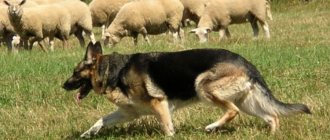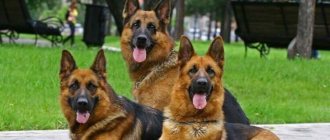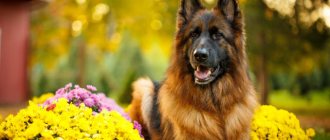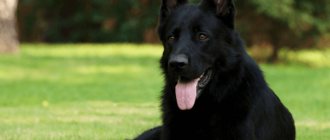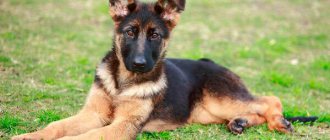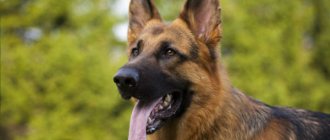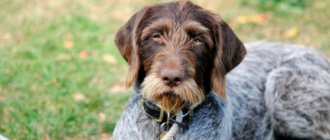In Germany, three types of universal hunting breeds were bred with one main difference - long hair. Langhaar has long hair, Drathaar has half-long hair, and Kurzhaar has short hair. However, Langhaar was and remains little known and most often not even mentioned in the context of German cops. The appearance of the breed is also not very helpful; the Longhaired German Pointer is very similar to the Setter, common features are noticeable even in the photo.
Origin of the breed
The history of the origin of Langhaars dates back to the 19th century, and experts still do not know for sure whether the ancestors of the pointers are water spaniels or whether they descended from the old German long-haired pointers. In any case, the dogs turned out to be excellent - with excellent performance characteristics, stable psyche and beautiful appearance.
The approval of the first standard occurred in 1879, but the requirements changed more than once after that, so modern langhaars are very different from the previous ones. Work to improve the qualities of the cops did not stop; they were infused with fresh blood, for example, kinship with setters made the dogs more graceful, dexterous and maneuverable.
The final standard of the breed was established only by 2000; its representatives are universal hunting dogs capable of working in almost any conditions. They have a sensitive nose, a high tracking ability, and a natural viciousness towards the beast.
Reviews
Yuri:
A wonderful dog both at work and at home. Knows when and how to behave. During the hunt, he is a dexterous, energetic and sensitive dog, and after that he turns into a calm and slow lazy person. I noticed that he really likes to play with children. It is a pity that the breed is not in demand, although many similar dogs can be found among pointers and setters.
Alexei:
I am an avid hunter and owner of several different pointers. To be honest, Langhaar is not comparable to anyone else. However, there is one drawback: he is sometimes lazy. But as soon as he feels the prey, all laziness disappears with his hand. As for me, this is a super hunter, and a universal one at that.
Description of the Langhaar breed
Initially, the breed was bred exclusively for hunting, so the appearance of the dogs is associated with their activities. Compared to other cops, the Langhaar has stronger bones, decently sized limbs and a long, beautiful coat.
The weight of dogs does not depend on gender and varies from 25 to 30 kg, but more stringent requirements are imposed on height : the height of males is 60-70 cm, the preferred parameters are 63-66 cm, for females this figure is 59-66 cm, preferable so that the height of the female does not exceed 63 cm.
The standard specifies the following description of the representatives of the breed:
- The head is proportional to the body, with clear outlines; in females it is smaller and somewhat narrower than in males. The forehead is of medium width, slightly convex, with a moderately pronounced occipital protuberance. A furrow separates the forehead. The stop creates a smooth line; there is a small hump on the back of the nose that emphasizes the shape.
- The muzzle is U-shaped, its length is equal to the frontal part, the lips are brown, medium-sized, not very “dry”, they completely cover the lower jaw.
- The teeth are quite strong, white, the bite is correct, like a “scissors”.
- The nose is smooth, square, the nostrils are well developed, mobile, open. Pigmented with a rich brown tint.
- The eyes are almond-shaped, expressive, attentive, with an intelligent look. The inner corners of the eyes are slightly drooping. The shade of the iris can be rich hazel or brown; the standard allows for light eye color, but they are undesirable.
- The ears are large, triangular with rounded tips, set wide apart, hanging down on moderately elastic cartilage. When the dog is calm, they press their cheeks.
- The body is a format close to square, the top line is graceful and falling.
- The neck is well muscled, set high, with a good arch and scruff. The withers are strong, like the shoulder girdle, and well defined.
- The chest is of harmonious size - moderately wide, deep, falling just below the elbows.
- The ribs are drawn out, strong roundness and protrusion are not allowed.
- The back is straight; if you look from the side, you can see that it descends from the shoulders to the croup when the dog takes a stance. The loin is short, merging into a wide, sloping croup. The belly line is selected, with a beautiful curve.
- The limbs are smooth, straight, the joints are strong, the muscles are well developed. The shoulder blades are pressed close to the body, of medium length, and do not rise above the line of the back. The elbows are directed back, but if the dog has a strongly developed chest, a slight turn outward is allowed. The joints are connected naturally, they indicate the strength and speed of the animal. The thighs are elongated, strong, with strong hocks.
- The paws are oval-shaped, the toes are collected, arched, with curved, brown claws. The pads are large in size, with elastic, brown skin.
- The tail is thick at the base, smooth in its natural form, covered with elongated, decorative hair. It is positioned and carried high, but does not assume a vertical position; when at rest it falls down. In working individuals, the tail is often docked by a third or half.
Coat quality and possible colors
The length of the fur is medium, varying between 3-5 cm, in some areas it is elongated. Guard hair with a slight wave, but curly hair is not allowed. The coat is not silky, without softness, it is rather hard, with an elastic structure. Langhaars also have a thick, abundant undercoat, but it does not separate the layer of guard hair from the body.
More often there are individuals with a solid color: light brown or the shade of fallen leaves. There are also long-haired pointers with brown fur, on which markings are located - white or in the form of gray (dark or light), while the color of the head and spots is brown. Individuals with a trout spotted color look original, when many small spots are located on a main white background.
Appearance
“A hunting dog of aristocrats,” is the first thought that arises when looking at the langhaar. And yes, indeed, it is very easy to imagine him running next to the horse of a noble German who is about to indulge in the favorite pastime of the medieval aristocracy - hunting.
In terms of its size, the breed is classified as a large medium-sized breed. The size standards are as follows:
- male height - 60-70 cm;
- female height - 58-66 cm;
- male weight - 27-32 kg;
- bitch weight - 25-31 kg.
Langhars have an elongated head, even a little dry. The eyes are located symmetrically and have well-closing eyelids. The ears are set high, drooping, and fit tightly to the dog’s cheekbones.
The German Langhaar has a strong body. He is harmoniously built, his body is almost square in shape. Wide chest, tucked belly, straight back, high withers. Limbs of medium length, very hardy. The whole body has well-developed muscles. To maintain it in this form, the German Langhaar needs regular and abundant physical exercise.
The colors of the breed are not very bright. German Langhaar photos only confirm this. All colors are quite restrained and go well with the overall appearance of the dog. The most common standards:
- dark chocolate;
- white and chocolate;
- roan roan;
- brown roan roan.
This palette is explained by the purpose of the breed. A hunting dog should not stand out from the background surrounding it, and the above palette provides excellent camouflage in forests and swamps (as evidence there are a number of photos from hunters), where Langhaars are most often used.
Character
Despite the fact that the breed is a hunting breed, it is not at all aggressive. Especially towards people. On the contrary, Langhaars are distinguished by their gentleness and loyalty. These are very affectionate dogs that get along well with children and, if trained, also with other animals.
There’s nothing to say about the cop’s intelligence. This is simply a mandatory feature of this type of breed. They must be able to make decisions independently when necessary. As well as obeying the owner unquestioningly, because in gun hunting this trait is vital for the dog.
One of the advantages is to be suspicious of strangers. In modern conditions, when theft of purebred dogs has become the norm, this trait is simply invaluable. Plus, in this case, you can safely let your children go with your pet and not be afraid for their safety. A four-legged nanny will be only too happy to tinker with them.
What to feed your pet
Like any purebred dog, Langhaar can be fed either prepared food or natural food.
Choose the most suitable food for your dog: “Probalance”, “Fest Choice”, “Pronature”, “Wolf’s Blood”, “Grandorf”, “Pedigree”.
If you choose the first option, then do not save money and buy only the highest quality food - super-premium class or holistic.
With the second option, try to base your diet on three components: natural meat (up to 50%), cereals (up to 40%), vegetables and herbs (up to 30%).
If your pet spends a lot of time hunting, it is more convenient to use dry food: they already contain all the substances the pet needs, do not require cooking, and are easy to store and transport.
Important! With natural feeding, it can be difficult to balance the diet and select foods so that the dog receives all the necessary nutrients. Therefore, if your pet eats natural food, it is advisable to give it additional vitamin complexes.
Care
Hunting breeds in general are not the most capricious. On the contrary, they must have a fairly strong body and tolerate temperature changes well. This is also true for Langhaars. Neither heat nor cold are a serious problem here (with the exception of plus or minus 30°C, but these are special cases).
Langhaar immunity is also quite high. They need a certain proportion of vaccines, but nothing overly strong is required. An examination of the paws, ears, teeth and eyes is all that is required of the owner. Well, also an annual visit to the veterinarian.
The main thing that is needed to maintain their health is a good diet and long walks. The first should consist of a sufficient proportion of meat and cereals along with large bones. And walking is the main problem in urban living for a busy person. An hour a day is the minimum for a cop. This can be limited only in the case of a bicycle walk or jog with a sufficiently hardy person who can at least part of the time maintain the pace set by the four-legged pet.
Langhaar wool also does not require special care. Thorns and dirt don’t stick to it much, and the texture itself protects against severe tangling. Weekly brushing is all that is needed to keep your dog's coat in good condition. You should bathe no more than once a month, unless the dog simply gets dirty in something.
All of the above in the description is true even for Langhaar puppies. Yes, babies are more vulnerable to illness and require a little more careful care. But there are no fundamental differences in this regard for Langhaar puppies.
general characteristics
Nobility, gentleness and intelligence - this combination turns the Langhaar dog into a very pleasant pet and valuable companion. He can guard the household, help look after children, keep a lonely person company and, of course, is simply invaluable on the hunt. Plus, he is quite suspicious of strangers, which reduces the likelihood of this rare dog being stolen.
Yes, Langhaar puppies are quite a rarity today, which also affects their price. But if you find a kennel or dog handler who knows where to get this handsome dog, then the problem will be solved. And the breed is worth such efforts, because its advantages are not limited to spiritual qualities and intelligence. Outwardly, she is also very beautiful and elegant, like all the best representatives of the cops.
Purpose
The hunting qualities of the langhaar are fine-tuned at the genetic level. These dogs have a calm, focused search, making them suitable for controlled hunts. Without any hesitation, the Langhaar will climb after a duck through the reeds, even into cold water. A dense undercoat and a sufficient level of sebum will protect the skin from getting wet and hypothermia. A keen sense of smell and a solid stance make him suitable for working in the field. Langhaar easily navigates wooded areas and is not afraid to go through dense thickets. Drives game with a voice. They hunt with it various species of birds, small animals and large ungulates.
Brief characteristics of the dog
- Other possible names: Deutscher Langhaariger Vorstehhund, German Longhaired Pointer, Langhaar, Deutsch Langhaar.
- Adult height: 58-70 cm.
- Weight: average 30 kg.
- Characteristic color: plain brown or with graying, white with brown spots or specks.
- Coat length: short, harsh, with dense undercoat and fringe on the paws, ears and tail.
- Life expectancy: 12-14 years.
- Advantages of the breed: smart, affectionate, intelligent, loves children, balanced, non-aggressive,
- Difficulties of the breed: long walks required.
- Average price: $400-$600.
Health
Unlike his "brothers", Langhaar is prone to a small number of diseases. However, illnesses typical of Kurzhaars cannot be ruled out. The Langhaar is active and has a spacious chest, which creates a risk for gastric volvulus. Hip dysplasia is quite common among all working breeds. Cataracts and eyelid disorders (eversion, entropion) are typical for almost all pointing breeds. As for narrow breed diseases, it is necessary to highlight: Hepatopathy - liver failure. Despite great progress in veterinary medicine, liver failure remains not fully understood.
Most often, treatment consists of supportive care and relief of obvious symptoms. Enterocolitis is a complex pathology accompanied by rarefaction or inflammation of the large and small intestines. Treatment depends on the underlying cause. Since Langhaars are not prone to allergies (the most common cause), diagnosis is quite difficult. Bursitis is the formation of bumps or dropsies due to the effusion of fluid into the interstitial space. The disease may not bother the dog at all, but is sometimes accompanied by pain. Treatment depends on the stage and depth of the lesion; most often it comes down to local procedures and supportive care.
Historical reference
According to generally accepted data, the German Langhaar is a descendant of Setters and Shorthaired Pointers. It is pointless to argue with this fact, since the arguments are “obvious”. Unlike their brothers, hunters from tip to tail, Langhaar are more versatile in training and work. Based on flexibility in perception, dog experts suggest that the ancestors of the breed included not only cops. By the way, the menacing appearance of the early Longhaired German cops alarms intuition - overweight, shaggy dogs with a large head and wide bones could not be gun dogs even in theory.
The active influx of Pointer blood allowed the breed to acquire characteristic exterior differences by 1877. However, “old-type cubs” continued to appear in litters. After 2 years, the first step was taken in the beginning of breeding work, or more precisely, the goal was set to obtain the same type of livestock. Work to obtain the standard Langhaar was carried out until the beginning of the Second World War. The breed turned out to be unadapted to front-line life, which led to the cessation of breeding work. The sharp decline in livestock numbers pushed the breeders back several steps at once. Despite the officially accepted description of the breed and recognition, the German Longhaired Pointer remains a rarity to this day.
Raising and training Langhaar
Representatives of this breed are smart and easy-going, so training will not cause any difficulties. In general, the dog respects the owner and will try to please, naturally, if he accepts him as a leader.
Hunting is in the blood of all German cops, so in this regard they do not require specialized training. They are naturally excellent hunters. But the pet must master the basic program. Also, from an early age, the puppy needs to be taken out into the world, to playgrounds, introduced to other dogs and people, and taken on public transport. This will relieve your pet from excessive shyness.
During training, the owner must be restrained, not show aggression and not use harsh methods. Otherwise, the pet becomes stubborn, wayward, and begins to behave defiantly. Dog handlers recommend using positive reinforcement and not forgetting about timely praise. Cops are sensitive to changes in voice, so sometimes it is enough to scold your pet for him to realize his mistakes.
Representatives of the breed are obedient by nature, but they will obey only an owner with a strong character, who will not show his weakness, but will show firmness and fortitude by training his pet.
AMERICAN TOY FOX TERRIER: HISTORY OF THE BREED AND CHARACTER OF THE DOG
ENGLISH SPRINGER SPANIEL: BREED CHARACTERISTICS AND HISTORY OF ORIGIN
AMERICAN AKITA: ORIGIN AND CHARACTER OF THE DOG
MONGOLIAN SHEPHERD BANKHAR: ORIGIN AND CHARACTER OF THE DOG
How to choose a healthy puppy
By the age of 2 months, puppies are ready to leave their mother and move to a new home with new owners.
By this period, their physical and mental development reaches a level where separation from the female is absolutely painless.
When choosing a pet, pay attention to the following points:
- The baby’s behavior will demonstrate the main character traits. If the puppy behaves actively, playfully, and makes contact, most likely, this is a future leader. An independent animal will show indifference soon after meeting, and a modest and insecure puppy will hide in the corner. Also observe how the puppies interact with each other, who leads and who obeys.
- Ask about the parents' hunting history if you plan to use the dog as a working companion.
- Assess your place of residence and conditions.
- It is equally important to choose a healthy baby, so examine the dog’s ears, eyes, teeth, mouth, and coat.
Important! To better understand the animal's character, do a test: lay the puppy on its back and lightly hold it with your palm on the sternum. If the baby actively breaks free and tries to bite you: in front of you, most likely, is the future leader. If the puppy flounders, squirms, tries to escape, but eventually calms down, this indicates a strong and rather stubborn character. But weak-willed kids will not make any attempts to free themselves; on the contrary, if you show strength, he will try to find contact.
The price of puppies depends on many factors (purity of the breed, availability of certificates from parents, purchases from professionals) and averages $600-800.
Conditions of detention of a German cop
Future owners should know in advance that the Langhaar is a very energetic, active pet that needs to splash out excess energy. It is best if the dog is involved in hunting, this is his favorite activity and brings a lot of pleasure.
Naturally, a dog living in an apartment, who goes outside only “out of necessity,” threatens furniture and other interior items. Therefore, it is recommended to keep your pet in an enclosure or provide it with long, active walks.
When kept outdoors, the langhaar should be provided with an insulated booth and a spacious enclosure. In summer, your pet should have a shady place where he can hide from direct sunlight. But even in this case, the dog requires daily walks, which should last at least an hour.
Appearance of the drathaar
The appearance of wire-haired cops is original and memorable. The strict, almost military bearing of the dog is complemented by the so-called busty muzzle, which gives the animal an impressive and overly serious appearance. For example, an adult drathaar has a drooping “mustache” and a sparse “beard”, which, combined with an inquisitive look, slightly “ages” it.
German Wirehaired Pointers are dogs of medium build, so the weight of the average representative of the breed should not exceed the limits of 23-32 kg approved by the standard. By the way, due to their somewhat “dried” constitution, drathaars almost do not suffer from obesity, although with an abundant diet and lack of physical activity they are able to “eat” a few extra kilograms.
Head
Drathaar puppies
A wide, slightly convex skull in the lateral parts with massive brow ridges and a flat back of the head. The muzzle is slightly humped, strong, of sufficient length and width. The stop (the transition from the frontal part to the muzzle) is well defined.
Jaws and teeth
The drathaar has large teeth, 42 in number. When the jaws close, the lower incisors overlap the upper ones (scissor bite).
Eyes
Not very large, not convex, set shallow. The eyelids cover the eyeball well. The color of the iris is dark brown. For puppies, a golden shade of the iris is considered acceptable, which becomes darker with age.
Ears
Small ones. The bases of the ears are set wide apart and located slightly above the line of the eyes (high set).
Drathhaar Muzzle
Frame
Slightly stretched out, with a sloping back and a strong, muscular loin. The croup is wide, with a slight slope. The drathaar's chest is deep and noticeably widened. The lower part of the body forms a single curved line due to the tucked abdomen and tightened groin areas.
The front legs are straight, with oblique shoulder blades and elbows pressed to the body. The wrists are strong, the pasterns are set at an angle. The hind limbs stand parallel to each other. The drathaar's thighs are massive and well muscled. The shins are elongated, dry; hock joints are strong. All four paws stand parallel, maintaining their position even when the animal moves. The paw pads are hard and rich in color.
Tail
Docked tail of a drathaar
Of moderate thickness, continues the line of the croup and is carried in a horizontal or slightly elevated position. Almost all purebred individuals have a docked tail. Exceptions are drathaars living in countries where this procedure is prohibited by law.
Wool
The coat consists of a “wirey” outer coat and an abundant waterproof undercoat, providing the animal with reliable protection from bad weather and accidental injuries. The optimal length of the drathaar's coat is 2-4 cm. The hair on the ears, head and belly is shorter than on the rest of the body.
On the dog's face, the hair forms expressive “eyebrows” and a “beard”.
Color
Dense speckled colors of black and brown tones are typical for drathaars, which are sometimes complemented by spots. Sparsely speckled options, as well as completely brown ones, are also acceptable. Brown colored individuals are allowed to have a white marking on their chest.
Defects and disqualifying defects
Defects in appearance that prevent show animals from receiving the highest score include incomplete dental formula, a short and overly pointed muzzle and sparse hair with a weakly defined undercoat. Drathaars with drooping eyelids, a hunchbacked or, conversely, concave back and twisted limbs are also not eligible for an “excellent” rating.
There are a number of requirements for the dog’s gait. For example, German Wirehaired Pointers should not amble or mince.
If we are talking about disqualification, then animals with such developmental defects as:
- malocclusion (underbite/overbite);
- distortion of one of the jaws;
- discord;
- entropy/ectropy;
- fracture or thickening of the tail;
- defective color.
Deviations of behavior are also included in the list of vices; accordingly, if they are detected, the issue of a show career for a pet will be closed forever. Most often, drathaars are disqualified for cowardice (fear of a shot, fear of game) and increased aggressiveness.
